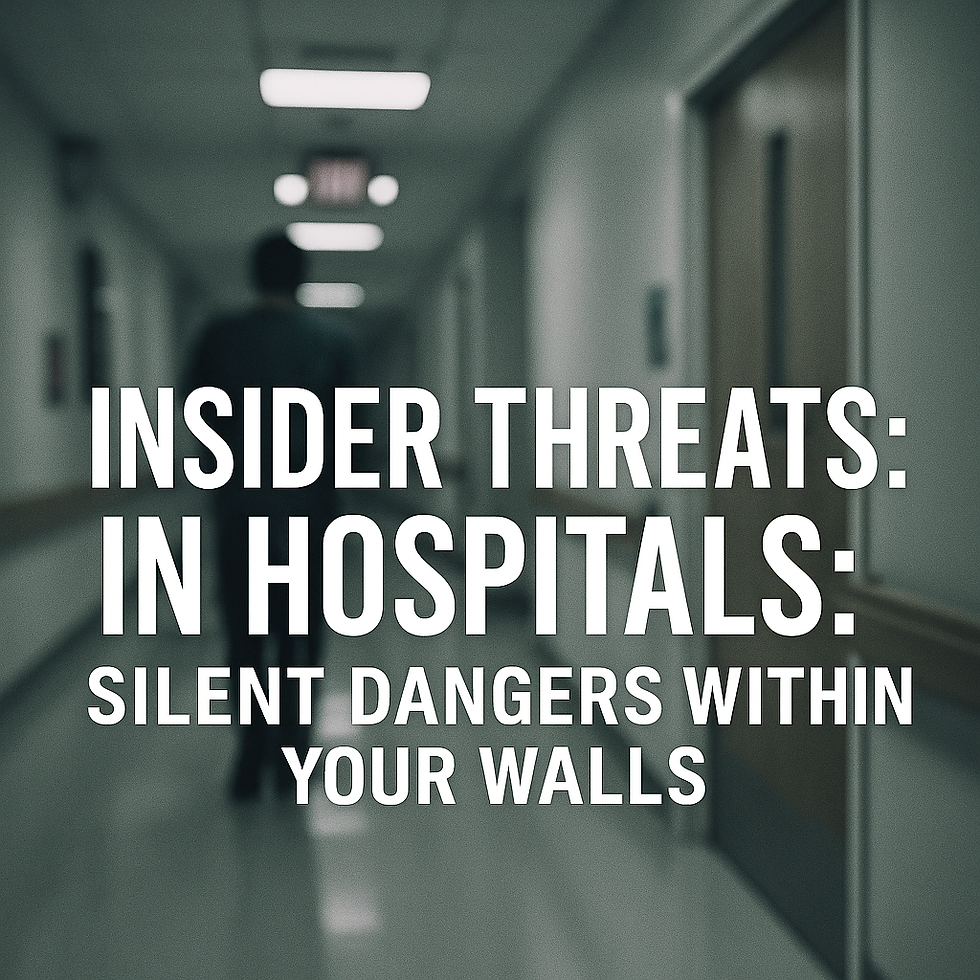Insider Threats in Hospitals: Silent Dangers Within Your Walls
- CrisisWire

- Sep 27
- 2 min read
The Hidden Threat Hospitals Ignore
Hospitals are designed for healing, but too often, they unknowingly harbor risks from within. While most leaders focus on external threats — like active shooters, natural disasters, or cyberattacks — the truth is unsettling: insider threats pose one of the most dangerous risks to patient safety and hospital operations.
These threats don’t always involve malicious intent. Sometimes, they stem from staff burnout, negligence, or lack of training. But other times, they’re deliberate — drug diversion by medical staff, sabotage of equipment, theft of patient records, or even targeted violence.
In a high-stakes environment like healthcare, one overlooked vulnerability can be catastrophic.
Real-World Cases of Insider Threats
Drug Diversion Scandals: Nurses and technicians stealing opioids, replacing them with saline, and leaving patients in pain while exposing them to infection.
Data Breaches: Insiders selling patient medical records to identity theft rings.
Targeted Violence: Staff using insider knowledge to bypass security measures and harm coworkers.
Vendor Misconduct: Contractors granted badge access entering restricted areas unsupervised.
These cases are not hypothetical — they’ve been documented across U.S. hospitals and have cost organizations millions in lawsuits, compliance fines, and public trust.
Why Insider Threats Are Different
Unlike external attackers, insiders:
Already Have Access — badges, logins, and knowledge of blind spots.
Blend In — they don’t raise suspicion because they belong.
Exploit Trust — hospitals rely heavily on trust, making oversight difficult.
Know the Weaknesses — insiders know which doors are unlocked, which cameras are fake, and which systems are ignored.
This makes them harder to detect — and far more dangerous.

5 Steps to Combat Insider Threats in Hospitals
Hospital leaders must adopt a proactive, layered approach to insider threat management. Here’s where to start:
Conduct Insider Threat Risk Assessments Review access control, badge issuance, vendor policies, and staff clearance procedures.
Establish a Behavioral Threat Assessment Team (BTAT)Include HR, security, clinical leadership, and legal to evaluate concerning behaviors.
Audit and Monitor Access Implement strict role-based access controls, badge audits, and visitor escort policies.
Encourage Reporting Without Fear Staff must feel safe reporting concerns about colleagues without retaliation.
Train, Drill, and Repeat Insider threats should be included in hospital emergency preparedness drills, just like fire or active shooter scenarios.
Why This Matters
Hospitals are lifelines of society. A single insider incident can erode patient trust, damage reputations, and expose leaders to lawsuits and regulatory penalties. The Joint Commission, OSHA, and DHS all emphasize the need for insider threat prevention — yet too many hospitals are still reactive instead of prepared. Ignoring insider threats isn’t just a risk. It’s a liability.
Resources & Next Steps
📌 Contact CrisisWire Threat Management Solutions to schedule a Hospital Insider Threat & Access Control Assessment today. Protect your staff, your patients, and your reputation.
📧 Email: crisiswire@proton.me🔗 Blog: CrisisWire Blog🔗 LinkedIn: Warren Pulley🔗 Amazon Book for Leaders: Locked Down: The Access Control Blueprint





Comments